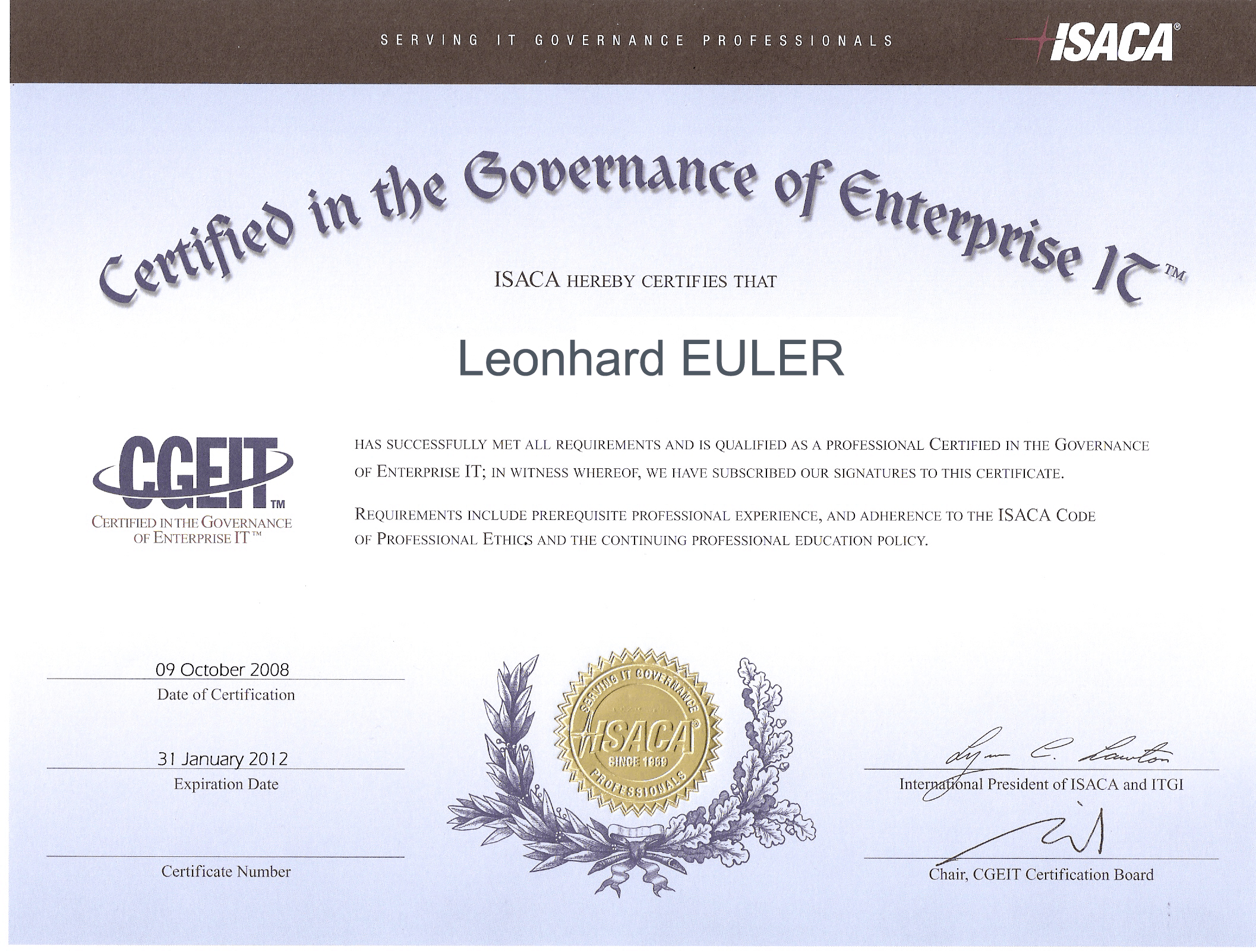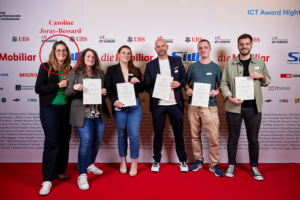- Domain 1: Framework for the Governance of Enterprise IT (25%)
Ensure the definition, establishment, and management of a framework for the governance of enterprise IT in alignment with the mission, vision and values of the enterprise.
Task Statements:- 1.Ensure that a framework for the governance of enterprise IT is established and enables the achievement of enterprise goals and objectives to create stakeholder value, taking into account benefits realization, risk optimization, and resource optimization.
- 2.Identify the requirements and objectives for the framework for the governance of enterprise IT incorporating input from enablers such as principles, policies and frameworks; processes; organizational structures; culture, ethics and behavior; information; services, infrastructure and applications; people, skills and competencies.
- 3.Ensure that the framework for the governance of enterprise IT addresses applicable internal and external requirements (for example, principles, policies and standards, laws, regulations, service capabilities and contracts).
- 4.Ensure that strategic planning processes are incorporated into the framework for the governance of enterprise IT.
- 5.Ensure the incorporation of enterprise architecture (EA) into the framework for the governance of enterprise IT in order to optimize IT-enabled business solutions.
- 6.Ensure that the framework for the governance of enterprise IT incorporates comprehensive and repeatable processes and activities.
- 7.Ensure that the roles, responsibilities and accountabilities for information systems and IT processes are established.
- 8.Ensure issues related to the framework for the governance of enterprise IT are reviewed, monitored, reported and remediated.
- 9.Ensure that organizational structures are in place to enable effective planning and implementation of IT-enabled business investments.
- 10.Ensure the establishment of a communication channel to reinforce the value of the governance of enterprise IT and transparency of IT costs, benefits and risk throughout the enterprise.
- 11.Ensure that the framework for the governance of enterprise IT is periodically assessed, including the identification of improvement opportunities.
- 1.Knowledge of components of a framework for the governance of enterprise IT
- 2.Knowledge of IT governance industry practices, standards and frameworks (for example, COBIT, Information Technology Infrastructure Library [ITIL], International Organization for Standardization [ISO] 20000, ISO 38500)
- 3.Knowledge of business drivers related to IT governance (for example, legal, regulatory and contractual requirements)
- 4.Knowledge of IT governance enablers (for example, principles, policies and frameworks; processes; organizational structures; culture, ethics and behavior; information; services, infrastructure and applications; people, skills and competencies)
- 5.Knowledge of techniques used to identify IT strategy (for example, SWOT, BCG Matrix)
- 6.Knowledge of components, principles, and concepts related to enterprise architecture (EA)
- 7.Knowledge of Organizational structures and their roles and responsibilities (for example, enterprise investment committee, program management office, IT strategy committee, IT architecture review board, IT risk management committee)
- 8.Knowledge of methods to manage organizational, process and cultural change
- 9.Knowledge of models and methods to establish accountability for information requirements, data and system ownership; and IT processes
- 10.Knowledge of IT governance monitoring processes/mechanisms (for example, balanced scorecard (BSC)
- 11.Knowledge of IT governance reporting processes/mechanisms
- 12.Knowledge of communication and promotion techniques
- 13.Knowledge of assurance methodologies and techniques
- 14.Knowledge of continuous improvement techniques and processes
- Domain 2: Strategic Management (20%)
Ensure that IT enables and supports the achievement of enterprise objectives through the integration and alignment of IT strategic plans with enterprise strategic plans.
Task Statements:- 1.Evaluate, direct and monitor IT strategic planning processes to ensure alignment with enterprise goals.
- 2.Ensure that appropriate policies and procedures are in place to support IT and enterprise strategic alignment.
- 3.Ensure that the IT strategic planning processes and related outputs are adequately documented and communicated.
- 4.Ensure that enterprise architecture (EA) is integrated into the IT strategic planning process.
- 5.Ensure prioritization of IT initiatives to achieve enterprise objectives.
- 6.Ensure that IT objectives cascade into clear roles, responsibilities and actions of IT personnel.
- 1.Knowledge of an enterprise’s strategic plan and how it relates to IT
- 2.Knowledge of strategic planning processes and techniques
- 3.Knowledge of impact of changes in business strategy on IT strategy
- 4.Knowledge of barriers to the achievement of strategic alignment
- 5.Knowledge of policies and procedures necessary to support IT and business strategic alignment
- 6.Knowledge of methods to document and communicate IT strategic planning processes (for example, IT dashboard/balanced scorecard, key indicators)
- 7.Knowledge of components, principles and frameworks of enterprise architecture (EA)
- 8.Knowledge of current and future technologies
- 9.Knowledge of prioritization processes related to IT initiatives
- 10.Knowledge of scope, objectives and benefits of IT investment programs
- 11.Knowledge of IT roles and responsibilities and methods to cascade business and IT objectives to IT personnel
- Domain 3: Benefits Realization (16%)
Ensure that IT-enabled investments are managed to deliver optimized business benefits and that benefit realization outcome and performance measures are established, evaluated and progress is reported to key stakeholders.
Task Statements:- 1.Ensure that IT-enabled investments are managed as a portfolio of investments.
- 2.Ensure that IT-enabled investments are managed through their economic life cycle to achieve business benefit.
- 3.Ensure business ownership and accountability for IT-enabled investments are established.
- 4.Ensure that IT investment management practices align with enterprise investment management practices.
- 5.Ensure that IT-enabled investment portfolios, IT processes and IT services are evaluated and benchmarked to achieve business benefit.
- 6.Ensure that outcome and performance measures are established and evaluated to assess progress towards the achievement of enterprise and IT objectives.
- 7.Ensure that outcome and performance measures are monitored and reported to key stakeholders in a timely manner.
- 8.Ensure that improvement initiatives are identified, prioritized, initiated and managed based on outcome and performance measures.
- 1.Knowledge of IT investment management processes, including the economic life cycle of investments
- 2.Knowledge of basic principles of portfolio management
- 3.Knowledge of benefit calculation techniques (for example, earned value, total cost of ownership, return on investment)
- 4.Knowledge of process and service measurement techniques (for example, maturity models, benchmarking, key performance indicators [KPIs])
- 5.Knowledge of processes and practices for planning, development, transition, delivery, and support of IT solutions and services
- 6.Knowledge of continuous improvement concepts and principles
- 7.Knowledge of outcome and performance measurement techniques (for example, service metrics, key performance indicators [KPIs])
- 8.Knowledge of procedures to manage and report the status of IT investments
- 9.Knowledge of cost optimization strategies (for example, outsourcing, adoption of new technologies)
- 10.Knowledge of models and methods to establish accountability over IT investments
- 11.Knowledge of value delivery frameworks (for example, Val IT)
- 12.Knowledge of business case development and evaluation techniques
- Domain 4: Risk Optimization (24%)
Ensure that an IT risk management framework exists to identify, analyze, mitigate, manage, monitor, and communicate IT-related business risk, and that the framework for IT risk management is in alignment with the enterprise risk management (ERM) framework.
Task Statements:- 1.Ensure that comprehensive IT risk management processes are established to identify, analyze, mitigate, manage, monitor, and communicate IT risk.
- 2.Ensure that legal and regulatory compliance requirements are addressed through IT risk management.
- 3.Ensure that IT risk management is aligned with the enterprise risk management (ERM) framework.
- 4.Ensure appropriate senior level management sponsorship for IT risk management.
- 5.Ensure that IT risk management policies, procedures and standards are developed and communicated.
- 6.Ensure the identification of key risk indicators (KRIs).
- 7.Ensure timely reporting and proper escalation of risk events and responses to appropriate levels of management.
- 1.Knowledge of the application of risk management at the strategic, portfolio, program, project and operations levels
- 2.Knowledge of risk management frameworks and standards (for example, RISK IT, the Committee of Sponsoring Organizations of the Treadway Commission Enterprise Risk Management—Integrated Framework (2004) [COSO ERM], International Organization for Standardization (ISO) 31000)
- 3.Knowledge of the relationship of the risk management approach to legal and regulatory compliance
- 4.Knowledge of methods to align IT and enterprise risk management (ERM)
- 5.Knowledge of the relationship of the risk management approach to business resiliency (for example, business continuity planning [BCP] and disaster recovery planning [DRP])
- 6.Knowledge of risk, threats, vulnerabilities and opportunities inherent in the use of IT
- 7.Knowledge of types of business risk, exposures and threats (for example, external environment, internal fraud, information security) that can be addressed using IT resources
- 8.Knowledge of risk appetite and risk tolerance
- 9.Knowledge of quantitative and qualitative risk assessment methods
- 10.Knowledge of risk mitigation strategies related to IT in the enterprise
- 11.Knowledge of methods to monitor effectiveness of mitigation strategies and/or controls
- 12.Knowledge of stakeholder analysis and communication techniques
- 13.Knowledge of methods to establish key risk indicators (KRIs)
- 14.Knowledge of methods to manage and report the status of identified risk
- Domain 5: Resource Optimization (15%)
Ensure the optimization of IT resources including information, services, infrastructure and applications, and people, to support the achievement of enterprise objectives.
Task Statements:- 1.Ensure that processes are in place to identify, acquire and maintain IT resources and capabilities (i.e., information, services, infrastructure and applications, and people).
- 2.Evaluate, direct and monitor sourcing strategies to ensure existing resources are taken into account to optimize IT resource utilization.
- 3.Ensure the integration of IT resource management into the enterprise’s strategic and tactical planning.
- 4.Ensure the alignment of IT resource management processes with the enterprise’s resource management processes.
- 5.Ensure that a resource gap analysis process is in place so that IT is able to meet strategic objectives of the enterprise.
- 6.Ensure that policies exist to guide IT resource sourcing strategies that include service level agreements (SLAs) and changes to sourcing strategies.
- 7.Ensure that policies and processes are in place for the assessment, training and development of staff to address enterprise requirements and personal/professional growth.
- 1.Knowledge of IT resource planning methods
- 2.Knowledge of human resource procurement, assessment, training, and development methodologies
- 3.Knowledge of processes for acquiring application, information, and infrastructure resources
- 4.Knowledge of outsourcing and offshoring approaches that may be employed to meet the investment program and operation level agreements (OLAs) and service level agreements (SLAs)
- 5.Knowledge of methods used to record and monitor IT resource utilization and availability
- 6.Knowledge of methods used to evaluate and report on IT resource performance
- 7.Knowledge of interoperability, standardization and economies of scale
- 8.Knowledge of data management and data governance concepts
- 9.Knowledge of service level management concepts
- Exam preparation
- Preparation Strategy
- Examinations white
Gouvernance des systèmes d’information, certification CGEIT
Gouvernance, sécurité, audit
Home » ISEIG Cours » Gouvernance des systèmes d’information, préparation à la certification CGEIT
Introduction
La certification CGEIT (Certified in the Governance of Enterprise IT) permet aux professionnels d'être reconnus pour leurs connaissances et leur expérience de la gouvernance de système d’information et l’application des bonnes pratiques correspondantes définies par l'ISACA - Information Systems Audit and Control Association.
Cette certification s'adresse à tout professionnel actif dans la gouvernance des systèmes d'information souhaitant faire reconnaître ses connaissances et compétences dans l'application des principes de la gouvernance du système d'information et l'application des bonnes pratiques correspondantes.
Cette certification couvre tous les domaines de l'audit des SI, des aspects organisationnels aux aspects les plus techniques. Elle sanctionne à la fois :
Documentation pdf ....
Cette certification s'adresse à tout professionnel actif dans la gouvernance des systèmes d'information souhaitant faire reconnaître ses connaissances et compétences dans l'application des principes de la gouvernance du système d'information et l'application des bonnes pratiques correspondantes.
Cette certification couvre tous les domaines de l'audit des SI, des aspects organisationnels aux aspects les plus techniques. Elle sanctionne à la fois :
- la réussite de l'examen CGEIT (150 questions à choix multiple en 4 heures, données 2024). Cet examen peut être passé par des candidats sans ou avec peu d'expérience.
- et la validation de 5 années d'expérience dans le domaine. Cette validation se fait sur la base d'un dossier à envoyer à l'ISACA. Le candidat a 5 ans à compter de la réussite de l'examen pour faire une demande de certification d'expérience.
Documentation pdf ....

La matière couverte par le CGEIT est continuellement actualisée pour répondre aux exigences en constante évolution. Elle est structurée dans les 5 domaines suivants :
Documentation pdf ...
- le cadre de référence de la gouvernance du SI
- l'alignement stratégique
- la fourniture de valeur
- l'optimisation des risques
- l'optimisation des ressources.
- d'acquérir, compléter et systématiser ses connaissances méthodologiques dans le domaine de la gouvernance des systèmes d’information
- de préparer la certification internationale CGEIT - Certified in the Governance of Enterprise IT.
- vous exercez dans le management des technologies de l’information
- vous avez de l’expérience dans des domaines liés à la gouvernance des systèmes et souhaitez élargir vos domaines de compétence
- vous avez de l'expérience dans la conception, le design, l'implémentation, la maintenance et le management de contrôles des systèmes d'information pour minimiser les risques
- vous souhaitez être reconnu pour votre expertise.
Documentation pdf ...
Prix, Dates, Inscription
La formation se déroule 2 fois par année à raison d'un jour par semaine. Les cours se déroulent généralement de 9h00 à 12h00 et de 13h30 à 17h00.
Gouvernance des systèmes d’information, certification CGEIT
Durée
4
Prix
CHF 3'000.-
Prix/j.
CHF 750.-
Cycle 1
29 sep, 6, 13, 20 oct 2025
Gouvernance des systèmes d’information, certification CGEIT
Durée
4
Prix
CHF 3'000.-
Prix/j.
CHF 750.-
Cycle 2
25 mar, 1, 8, 15 avr 2026
Le prix du cours comprend toute la documentation pédagogique distribuée qui comprend des ouvrages, les supports de cours et supports de présentation, exercices avec corrigés et examens à blanc avec corrigés.
Le prix de l'examen, non compris, s'élève à USD 575.- pour membre de l'ISACA ou USD 760.- pour non membre (tarifs 2024).
Selon notre expérience, la réussite des examens implique en plus du cours et des exercices dirigés, un travail personnel d´assimilation conséquent dont la charge est estimée à 2 jours par jour de cours suivi.
Le prix de l'examen, non compris, s'élève à USD 575.- pour membre de l'ISACA ou USD 760.- pour non membre (tarifs 2024).
Selon notre expérience, la réussite des examens implique en plus du cours et des exercices dirigés, un travail personnel d´assimilation conséquent dont la charge est estimée à 2 jours par jour de cours suivi.
Programme détaillé
Les 5 domaines de connaissances suivants sont présentés dans ce cours :
- le cadre de référence de la gouvernance du SI
- l'alignement stratégique
- la fourniture de valeur
- l'optimisation des risques
- l'optimisation des ressources.
Pour qui
- gestionnaire ayant l’intérêt et la volonté de se spécialiser dans la gouvernance des entreprises et particulièrement dans la gouvernance des systèmes d’information
Objectifs
- connaître le modèle de la gouvernance IT proposé par l'ISACA pour s’assurer de la définition et de la mise en oeuvre des leaderships, des structures organisationnelles et des processus de gouvernance
- savoir aligner la stratégie informatique à la stratégie métier pour s’assurer de la contribution des services IT à l’optimisation des processus métier
- savoir valoriser les livrables pour s’assurer de la fourniture des solutions et des services à temps et au prix convenu
- savoir manager les risques pour s’assurer de l’existence d’un cadre approprié de gestion des risques et de son alignement aux standards appropriés
- savoir manager les ressources pour s’assurer de la capacité suffisante en ressources de l’IT pour exécuter les tâches courantes et futures
- savoir mesurer les performances pour s’assurer de l'adéquation de la contribution des objectifs IT aux objectifs des métiers de l’entreprise
- s'entraîner au déroulement de l'examen de certification
Prérequis
- connaissances de base de l'informatique (processus, technologie, organisation)
- connaissances des processus de gouvernance d'entreprise
- tout candidat peut se présenter à l'examen mais n'obtiendra la certification que lorsqu'il aura réussi l'examen et pourra justifier de 3 ou 5 années d'expérience dans la gouvernance des SI selon les règles définies par l'ISACA (voir www.isaca.org)
- bonnes connaissances de l'anglais technique écrit, une partie des documents de cours et les questions d'examen étant en anglais
- le candidat est prêt à investir du temps de préparation entre les sessions de formation (révision / questions d'examen)





